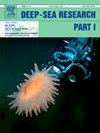印度洋中印度洋脊下地壳再循环与地幔非均质性
IF 2.1
3区 地球科学
Q2 OCEANOGRAPHY
Deep-Sea Research Part I-Oceanographic Research Papers
Pub Date : 2025-03-10
DOI:10.1016/j.dsr.2025.104484
引用次数: 0
摘要
本文建立了一个新的数据库,包括印度洋中脊(CIR)玄武岩的矿物化学、全岩石地球化学和Sr-Nd同位素组成,以评价熔体生成过程、源区特征和构造对印度洋地幔演化的控制作用。亚碱性、拉斑岩到过渡型中印度脊玄武岩(CIRB)的显著地球化学特征是HFSE上相对较高的LILE和LREE丰度,HFSE丰度相对于原始地幔组成呈负Nb、Zr、Hf异常和Nb/Nb∗<;1、Zr/Zr∗<1、Hf/Hf∗<;1的亏缺;相对于OIB (Nb/Y: 1.66, Zr/Y: 9.66),微量元素的变化反映了从N-MORB到E-MORB的明显偏差,Nb/Y(平均值:0.08)和Zr/Y(平均值:3.00)值非常低。显示Ba/Nb>;6、Rb/Nb>0.6、Nb/U<;42和Ce/Pb<;22的CIRB样品符合BABB滤波,从而保留了过去的俯冲信号,并验证了俯冲修饰源幔的证据。Sr-Nd同位素比值为87Sr/86Sr: 0.702810 ~ 0.703518, 143Nd/144Nd: 0.5128331 ~ 0.513118 (ƐNd: +3.77 ~ +9.37),反映了地幔端元源幔的富集非均质。印度洋中洋脊(MOR)地幔的化学非均质性证明了CIR玄武岩的主要HIMU-EM1特征和次要EM2特征。HIMU-EM1同位素变化趋势与DMM-N-MORB差异明显,CIRB的Nb/Y、Nb/Yb、Nb/U、Nb/Th低于OIB和N-MORB, Ba/Nb、Ba/Th、Ba/La、Nd/Hf、Ce/Nb高于OIB和N-MORB,表明OIB组分或深部地幔柱源对地幔源成分多样性没有影响。相反,这些特征将CIRB源幔的丰度归因于:(i)对流驱动的古俯冲交代洋壳(HIMU)的再循环;(ii)冈瓦南SCLM、LCC和UCC的拆沉、分散和稀释。本研究将印度洋地幔的化学演化及其普遍的非均质性与多时性构造事件等同起来,这些构造事件涉及超大陆的循环合并和解体,与海洋盆地的闭合和开放同步,系统地将古代岩石圈成分回收到地幔中。本文章由计算机程序翻译,如有差异,请以英文原文为准。
Crustal recycling and mantle heterogeneity beneath the Central Indian ridge, Indian Ocean
This study presents a new database including mineral chemistry, whole rock geochemistry and Sr-Nd isotopic compositions for basalts recovered from the Central Indian Ridge (CIR) with a view to evaluate melt generation processes, source characteristics and tectonic controls on Indian Ocean mantle evolution. The salient geochemical characteristics of the subalkaline, tholeiitic to transitional Central Indian Ridge Basalt (CIRB) are marked by relatively higher abundances of LILE and LREE over HFSE, depletion in HFSE abundances with respect to primitive mantle compositions corroborated by negative Nb, Zr, Hf anomalies and Nb/Nb∗<1, Zr/Zr∗<1, Hf/Hf∗<1; depleted to moderate enrichment of LREE and MREE over HREE and trace element variations reflecting distinct deviation from N-MORB to E-MORB with very low Nb/Y (avg.: 0.08) and Zr/Y (avg.: 3.00) values with respect to OIB (Nb/Y: 1.66, Zr/Y: 9.66). The CIRB samples showing Ba/Nb>6, Rb/Nb>0.6, Nb/U<42 and Ce/Pb<22 conform to the BABB filter thereby preserving past subduction signals and validating the evidence for a subduction-modified source mantle. The Sr-Nd isotopic ratios yielded the following ranges: 87Sr/86Sr: 0.702810–0.703518 and 143Nd/144Nd: 0.512831–0.513118 (ƐNd: +3.77 to +9.37), reflecting an enriched heterogeneous mantle end-member source mantle. Isotopic mixing calculations identify major HIMU-EM1 signature with minor EM2 component for CIR basalts attesting to the chemical heterogeneity of the Indian Ocean mid oceanic ridge (MOR) mantle. The major HIMU-EM1 isotopic trend, distinct deviation from DMM-N-MORB with lower Nb/Y, Nb/Yb, Nb/U, Nb/Th and higher Ba/Nb, Ba/Th, Ba/La, Nd/Hf, Ce/Nb for CIRB in comparison with OIB and N-MORB suggest that OIB component or deep mantle plume sources had no influence on the compositional diversity of the mantle source. Instead, these features attribute the fertility of CIRB source mantle to: (i) convection driven recycling of ancient, subducted, metasomatized oceanic crust (HIMU) and (ii) delamination, dispersion and dilution of Gondwanan SCLM, LCC and UCC. This study equates the chemical evolution of the Indian Ocean MOR mantle and its pervasive heterogeneity with polychronous tectonic events involving cyclic amalgamation and disintegration of supercontinents synchronized with ocean basin closure and opening that systematically recycled ancient lithospheric components into the mantle.
求助全文
通过发布文献求助,成功后即可免费获取论文全文。
去求助
来源期刊
CiteScore
4.60
自引率
4.20%
发文量
144
审稿时长
18.3 weeks
期刊介绍:
Deep-Sea Research Part I: Oceanographic Research Papers is devoted to the publication of the results of original scientific research, including theoretical work of evident oceanographic applicability; and the solution of instrumental or methodological problems with evidence of successful use. The journal is distinguished by its interdisciplinary nature and its breadth, covering the geological, physical, chemical and biological aspects of the ocean and its boundaries with the sea floor and the atmosphere. In addition to regular "Research Papers" and "Instruments and Methods" papers, briefer communications may be published as "Notes". Supplemental matter, such as extensive data tables or graphs and multimedia content, may be published as electronic appendices.

 求助内容:
求助内容: 应助结果提醒方式:
应助结果提醒方式:


